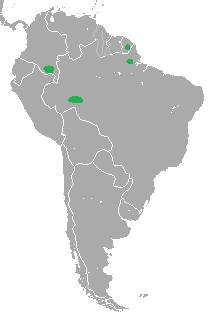Tapirus kabomani
| Tapirus kabomani | |
|---|---|
|
Not evaluated (IUCN 3.1)
|
|
| Scientific classification | |
| Kingdom: | Animalia |
| Phylum: | Chordata |
| Class: | Mammalia |
| Order: | Perissodactyla |
| Family: | Tapiridae |
| Genus: | Tapirus |
| Species: | T. kabomani |
| Binomial name | |
|
Tapirus kabomani Cozzuol, Clozato, Holanda, Rodrigues, Nienow, de Thoisy, Redondo & Santos, 2013 |
|
 |
|
| Areas in which T. kabomani is known to occur | |
Tapirus kabomani (also known as the little black tapir or kabomani tapir) is one of five extant species of tapir, large browsing mammals similar in shape to a pig. It is the smallest tapir species, even smaller than mountain tapir (T. pinchaque), which had been considered the smallest. T. kabomani is found in the Amazon rainforest, where it appears to be sympatric with the South American tapir (T. terrestris). When it was announced in December 2013, T. kabomani was the first odd-toed ungulate discovered in over 100 years.
With an estimated mass of only 110 kg (240 lb), T. kabomani is the smallest living tapir. For comparison, the mountain tapir has a mass between 136 and 250 kg (300 and 551 lb).Tapirus kabomani is roughly 130 centimetres (51 in) long and 90 centimetres (35 in) in shoulder height.
It used to be considered to be merely a different phenotype of T. terrestris. T. kabomani can be differentiated by its coloration: it is a range of darker grey to brown than T. terrestris. This species also features relatively short legs for a tapir caused by a femur length that is shorter than dentary length. The crest is smaller and less prominent.T. kabomani also seems to exhibit some level of sexual dimorphism as females tend to be larger than males and possess a characteristic patch of light hair on their throats. The patch extends from the chin up to the ear and down to the base of the neck.
Head and skull attributes are also important in identification of this species. This tapir possesses a single, narrow, low and gently inclined sagittal crest that rises posteriorly from the toothrow.T. kabomani skulls also lack both a nasal septum and dorsal maxillary flanges. The skull possesses a meatal diverticulum fossa that is shallower and less dorsally extended than those of the other four extant species of tapir.
...
Wikipedia
